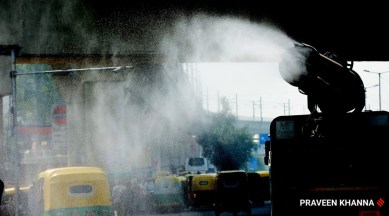Stay updated with the latest - Click here to follow us on Instagram
Delhi: Most monitoring stations record ‘very poor’ 24-hour average AQI
The prominent pollutant at most of these monitoring stations was PM2.5. PM2.5 comprises small particles of 2.5 micrometers or less.

Out of the 34 air quality monitoring stations in Delhi for which the 24-hour average Air Quality Index was available at 10 am Monday, most stations recorded AQI in the ‘very poor’ category. According to a forecast issued by the Air Quality Early Warning System Sunday, the AQI is likely to be in the ‘very poor’ category Monday.
As many as 22 out of the 34 stations had ‘very poor’ 24-hour average AQI. One station—the one at Anand Vihar—had the worst AQI of 402 in the city, which is in the ‘severe’ category. Ten air quality monitoring stations had AQI in the ‘poor’ category, while a single monitoring station recorded ‘moderate’ AQI, according to data from the Central Pollution Control Board (CPCB). The monitoring station at ITO for instance recorded a 24-hour average AQI of 313 at 10 am, while the figure was higher at 320 at the Jawaharlal Nehru Stadium.
monthly limit of free stories.
with an Express account.
The prominent pollutant at most of these monitoring stations was PM2.5. PM2.5 comprises small particles of 2.5 micrometers or less.
Data from the Delhi Pollution Control Committee (DPCC) indicates that the PM2.5 concentration at some monitoring stations has breached the 300 µg/m3 mark over the past 24 hours. This is around five times the standard. For PM2.5, the 24-hour standard is 60 µg/m3, according to the National Ambient Air Quality Standards.
At 7 pm Sunday, Nehru Nagar recorded a PM2.5 level of 324 µg/m3, while it was 370 µg/m3 at Jahangirpuri at 8 pm on Sunday.
Meanwhile, stubble-burning-related fire counts have increased in Punjab and Haryana, data from the Indian Agricultural Research Institute shows. On Sunday, Punjab recorded 902 instances of crop residue burning, up from 582 the previous day. Similarly, Haryana recorded 217 instances which are up from 122 on Saturday.
A forecast issued by SAFAR had said on Saturday that the contribution of stubble burning to Delhi’s air quality is likely to increase from Monday onwards.